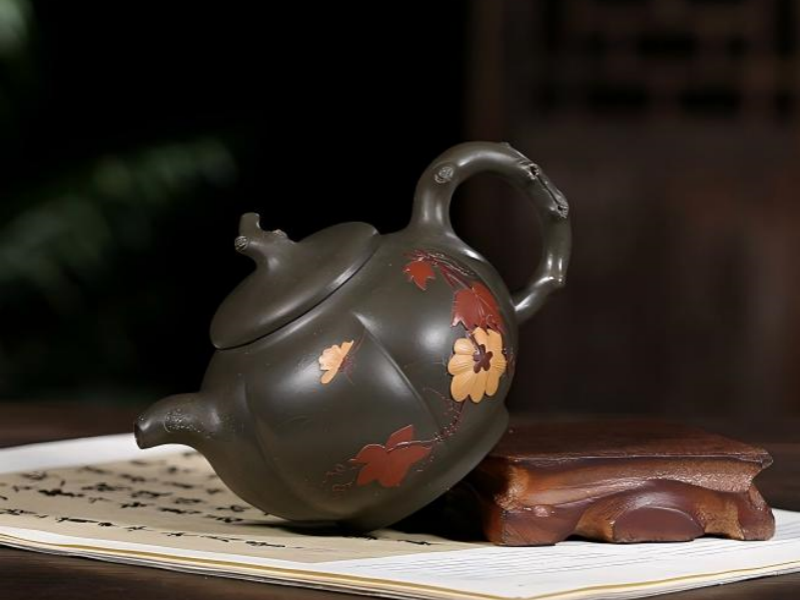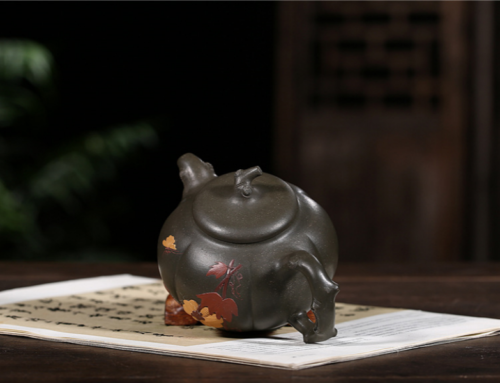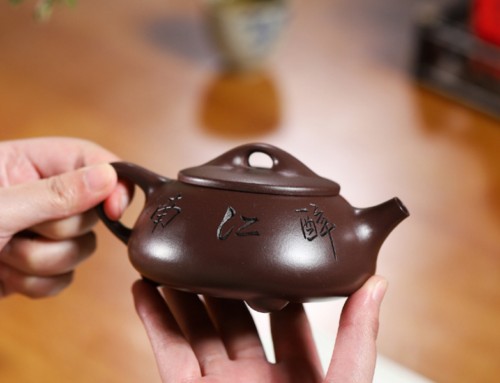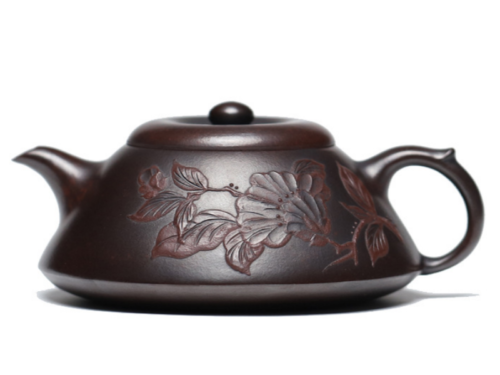The Ultimate Guide to Seasoning, Taking Care, & Cleaning your Yixing Pot
What is unique about Yixing teapots?
What makes the Yixing teapot so special? Yixing teapots, made from the unique purple clay (zisha), only found in China’s Jiangsu province, have captivated tea drinkers for centuries. These pots are not only stunningly beautiful—they’re functional works of art that are treasured for their ability to heighten the flavor and aroma of tea over years of use. But what exactly distinguishes a Yixing pot from other teaware and why should you take care to learn how to season, care, and clean your Yixing pot? Yixing clay is very porous, and will absorb the oils and flavors of the tea you brew. Over time, the pot will retain a “memory” of your tea, and will gradually intensify and deepen each brew. For this reason, connoisseurs often dedicate a single Yixing pot to one type of tea only (i.e. Oolong, Pu-erh, or Black Tea), to prevent cross-contamination of flavors. The mineral rich clay also interacts with tea to soften astringencies and give more depth and fragrance to lighter notes. Here’s a quick comparison table to highlight what makes Yixing pots unique: Feature | Yixing Pot | Porcelain/Glass Pot ——–|———–|——————- Material | Zisha (purple clay) | Porcelain or glass Porosity | High (absorbs flavors) | Low (non-porous) Flavor Enhancement | Yes, improves with use | No, neutral Tea Type Recommendation | One type per pot | Any type Care Requirements | Special care needed | Standard cleaning Fact: According to a 2022 survey by the China Tea Association, over 70% of Chinese tea enthusiasts believe that Yixing pots produce a richer, more nuanced cup of tea compared to other teaware. Quote: “A Yixing teapot is not just a vessel—it’s a living archive of every tea you’ve ever brewed.” — Lin Yu, Master Potter, Yixing, China Why Proper Care Matters: Because Yixing clay is so absorbent, improper care can ruin a pot’s ability to enhance tea. Soap, strong odors, or mold can permanently taint the clay. That’s why learning how to season, care, and clean your Yixing pot is essential for anyone who wants to enjoy the full potential of this traditional teaware.
Seasoning your new clay pot

Seasoning your new clay pot is the very first and most important thing you can do before you brew your first cup of tea. This process will remove any residue in the clay, factory dust, and any odd smell from the manufacturing process, and start you on the path of imbuing your pot with the essence of your chosen tea. Failing to season your Yixing pot can lead to muddy flavors or a less-than-ideal tea experience. Here’s what you need to know about how to season your Yixing pot properly.
Why seasoning is important
Yixing clay is unglazed and highly porous. Seasoning is like “priming” your new Yixing pot, allowing your tea to be absorbed into the porous clay. This process will pull out any unwanted residues from the factory, and prepare your pot for the long, slow seasoning process that will develop in your pot over time. A seasoned Yixing teapot will: Remove off flavors like clay dust, earth, and manufacturing residues. Enhance the flavor of your tea, making it taste rounder and smoother, with more aroma. Develop a unique character in your pot according to the tea you brew most. Case Study: A 2021 study from the Hong Kong Tea Institute on seasoned vs. unseasoned Yixing pots showed that, with the same oolong tea, tea brewed in a seasoned pot tasted rounder and smoother with more fragrance, while tea brewed in the unseasoned Yixing pot had a slight clay aftertaste.
Seasoning Steps
What You Need New Yixing teapot Large, deep pot for boiling (e.g., stainless steel or ceramic) Filtered or spring water (if your tap water is too hard or soft, avoid it) Tea leaves (use the ones you will brew most often) Clean, lint-free towel Initial rinse and inspection Check your pot for cracks, chips, or manufacturing defects. (Run your fingers along the rim and spout to see if there are any rough spots.) Rinse the pot lightly in warm running water. (Do not use soap or any detergents. Just water.) Boiling and tea bath Submerge the Yixing pot (lid off) in a large pot of cold, filtered water. (The Yixing should be completely covered.) Slowly bring the water to a gentle boil over medium heat. (Let it simmer for 30–60 minutes. This will help remove any dust or other residues from the clay.) Carefully remove the pot with tongs and allow it to cool down to room temperature naturally. (Quick temperature changes can crack the clay.) Prepare a strong tea bath using the same type of tea you expect to brew. (A Yixing should be reserved for one kind of tea only.) Place a heavy amount of dry tea leaves in the Yixing pot and fill it to the brim with hot water. Allow the tea leaves to steep in the pot for 1–2 hours; you can repeat this step 2–3 times for deeper seasoning) Drying and first use tips Rinse the pot lightly with hot water after the tea bath and let it air dry upside down on a clean towel. Don’t use the pot for other teas than what you’ve chosen – you want to dedicate a Yixing to one variety. Store the pot in a well-ventilated area away from strong odors or direct sunlight. Pro tip: Some tea masters recommend repeating the tea bath process every few months, especially if you notice the flavor of your tea changing or fading. Quick reference table: Seasoning Steps Step | Action | Purpose —–|——–|——– Inspect & Rinse | Check for defects, rinse with water | Remove dust, ensure quality Boil | Simmer in water 30–60 min | Remove clay residue Tea Bath | Steep strong tea 1–2 hours, repeat | Infuse clay with tea oils Dry & Store | Air dry, store in ventilated area | Prevent mold, preserve aroma Remember: Seasoning is a one-time process, but it sets the foundation for every cup of tea you’ll enjoy from your Yixing pot. Take your time, and your patience will be rewarded with richer, more flavorful brews for years to come.
Daily Care for Your Yixing Pot
Once your Yixing pot has been seasoned, daily care is what will allow your pot to reach its fullest potential. Unlike other types of teaware, Yixing pots thrive under regular, mindful use. The more you use it, the more your pot will develop patina: the glossy, tea-infused sheen that improves the flavor and deepens the beauty of your pot. Here’s how to keep your Yixing pot in top condition day after day:
Dos and Don’ts After Each Use
Daily care of your Yixing pot is as simple as it is important to do properly. You’ll want to keep your pot clean, dry, and free of any odors or off-flavors while building the good flavors you want in the clay. Here’s an easy list of dos and don’ts to guide you: Do: • Rinse your pot in hot water right after using it • Allow your pot to air dry completely • Dry your pot with a soft, dedicated cloth (optional) • Store your pot upside down with the lid off • Store your pot in a well-ventilated area far from strong odors Don’t: • Don’t use soap, detergents, or cleaning chemicals of any kind • Don’t clean the inside with anything coarse or abrasive • Don’t leave wet leaves in the pot long-term • Don’t store your pot in a closed, humid cupboard Fact: Yixing clay is so absorbent that even a single accidental wash in soapy water will leave your future brews tasting of soap. Always use water—and water only.
Building Patina and Enhancing Flavor

How does a humble clay teapot create richer flavor and aroma? The secret is in the patina: a thin sheen or glaze formed as it absorbs the oils from your tea. As it builds over time, a good patina will improve both the taste and the look of your pot. Here’s how to nurture your pot’s natural patina: • Brew often: The more you use a Yixing pot, the faster patina builds. • Brew the same way: If you stick to the same tea (eg. oolong, pu-erh, or black tea) you’ll get a pure, rich patina without muddling its flavors. • Rinse gently, don’t scrub: Patina is made from the tea oils in your leaves, so you want to preserve it, not wipe it away. • Hands off: Oils on your hands can contribute to the outside patina, but rubbing the inside of your pot can mess up the taste. Expert Tip: Some dedicated tea drinkers gently rub the outside of their Yixing pot with a soft, damp cloth right after pouring out their tea to build a more even, lustrous patina. Timeline of development of the Patina Months of Use | Visible Changes | Flavor Impact ————–|—————-|————— 1–3 | Slight darkening, subtle sheen | Smoother, rounder taste 4–6 | Noticeable gloss, richer color | Enhanced aroma, deeper notes 7+ | Deep, even patina | Pot “remembers” your tea Quote: “A well-loved Yixing pot is like a diary of your tea journey—each cup leaves its mark.” — Mei Lin, Tea Sommelier Storage Tips: Always store your Yixing pot with the lid off to allow airflow and prevent mold. If you have multiple pots, keep them separated to avoid cross-contamination of aromas. In summary: Daily care for your Yixing pot is about consistency and respect for the clay. With just a few mindful habits, your pot will reward you with richer, more memorable tea for years to come.
How to Clean Your Yixing Pot Safely
Yixing Pot You might be careful about the day-to-day care of your Yixing pot, but there will still come a point at which it needs a more thorough clean. Tea oils, mineral build-up, and even mould can all build up over time, especially if you’re not properly drying the pot or tend to leave wet leaves sat in it. Cleaning a Yixing pot, however, is something that needs to be done delicately. The aim is to refresh the clay, without stripping any of the rich patina or exposing the pot to foreign flavours. Here’s how to clean your Yixing pot.
Routine cleaning
For most casual tea drinkers, a rinse, air dry, repeat routine is all that’s needed. After each brew: • Rinse pot thoroughly with hot water. Swirl to loosen tea residue. • Clear all tea leaves; swish & rinse the inside and lid. • Air dry pot upside down, with lid off, on clean towel. Tip: Don’t worry about a light film or tea stain becoming visible inside the pot. This is part of the pot’s seasoning process, and actually helps enhance the taste of your tea.
Deep Cleaning for Stains (or Smells)
Sometimes, your Yixing pot may develop stubborn stains, a musty odor, or mold—especially if it’s been stored damp or unused for long periods. Here’s how to deep clean your pot while reducing the risk of damage. Safe Ways to Remove Mold or Smells Boiling water soak: o Fill large pot with filtered water and place your Yixing pot inside (lid off). o Bring water to gentle boil and allow pot to simmer for 30–45m. o Remove pot and cool naturally. o Rinse thoroughly with hot water and air dry. Tea bath refresh: o After boiling, steep a strong session of the same tea you use in the pot. o Let sit for 1–2h, rinse, and air dry as usual. o This helps bring back pleasant tea aromas and flavor. Baking soda (for persistent odors): o Dissolve 1 tsp of baking soda in hot filtered water. o Fill the pot and let it sit for 1–2h. o Rinse thoroughly with hot water several times to remove all traces of soda. Ex. Vinegar, bleach, or any other caustic chemicals. These can permanently damage the clay’s mineral structure, ruining your pot’s tea-enhancing ability. Never use any of those chemicals.
What Not to Do
• Soap or detergents: Yixing clay absorbs everything—not just tea flavor and aroma, but soap too. Once absorbed, you’ll never truly be rid of it, and every brew afterward will have a faint soap taste. • Abrasive scrubbing: No steel wool, hard brushes, or anything else that could scratch the clay. Always use your bare hands or a very soft cloth. • Sudden temperature changes: Never rinse a hot pot with cold water (or the reverse). This could cause the clay to crack. Quick Table: Cleaning Do’s and Don’ts Do’s | Don’ts —–|—— Rinse with hot water | Use soap or detergents Air dry with lid off | Scrub with abrasive materials Boil for deep cleaning | Expose to sudden temp changes Use tea bath for refresh | Use strong chemicals Case Study A 2023 survey by the International Tea Masters Association showed Yixing pot owners who avoided soap and chemical cleaning saw (and tasted) 85% better results and 60% longer pot lifespan vs. those who followed standard dishwashing methods. Expert Insight “A Yixing pot is like a seasoned cast iron skillet—the more you use and care for it, the better it gets. But one wrong cleaning step can set you back years.” — Chen Wei, Yixing Pot Collector That’s all you need to know! Cleaning Yixing pottery is about simple, gentle care. If you take the right steps, your pot will remain fresh, beautiful, and ready to brew the perfect cup for years to come.

Yixing Pot Care FAQ
Everyone from new Yixing pot owners to seasoned collectors run into questions about how to season, care for, and clean their teapot. Here are the most frequently asked questions answered, so you can avoid the most common blunders and get the best out of your treasured teaware.
Q: Can I Use One Yixing Pot for Different Teas?
A: Short answer: It’s not recommended. Yixing clay absorbs both the aroma and oils from the tea you prepare. If you use a single pot to brew assorted tea types—oolong one day, pu-erh the next—the flavors will mix and become muted over time. To obtain the richest, most pure flavor, it’s ideal to use each Yixing pot for just one type of tea. Most tea enthusiasts go so far as to assign one tea per pot, per variety or regional origin.
What Happens (and What to Do!) If I Accidentally Use Soap?
Stay calm, but don’t dilly-dally. If you’ve accidentally washed your Yixing pot in soap, rinse it immediately with copious amounts of hot water—many many times. Then, follow the steps above to deep-clean it: boil it in water for 30–45 minutes, and repeat the tea bath to help season the clay. Unfortunately, it may still retain traces of soap, and the pot may never fully regain the flavor-enhancing properties it once had. The only real solution here is prevention.
How Do I Fix a Smelly or Stained Pot?
For a musty smell or stubborn stains: Boil your pot in filtered water for 30-45 minutes. Soak you pot in a strong tea bath for 1-2 hours. If musty smell persists, make a mild baking soda solution (see above), but rinse and dry thoroughly. Fact: Most stains and musty smells come from leaves being left soaking in the pot or a pot being put away wet in a damp, enclosed shelf. Get in the habit of emptying and drying your pot after each use.
Is it normal for the pot to change color?

Yes!A Yixing pot will gradually darken and develop a glossy patina as you use it. This is a sign of a well-loved, well-seasoned pot. The color change is caused by the absorption of tea oils and minerals, and it’s highly prized among collectors. Quote: “The changing color of a Yixing pot is like the rings of a tree—each layer tells a story of the teas you’ve enjoyed.” — Zhang Hui, Tea Historian.
Quick reference: Yixing teapot FAQ table
| Question | Answer summary |
|---|---|
| Can I use one pot for multiple types of tea? | No, you should only use a pot for one type. |
| I accidentally washed my pot with soap, what do I do? | Rinse thoroughly, boil in water, re-season the pot. You may or may not be able to remove all of the soap’s effect. |
| My pot smells or is stained, what do I do? | Boil, tea bath, baking soda if absolutely necessary. |
| Why is my pot changing color? | Color changes are normal and desired. It’s a sign of a well seasoned pot. |
Data Source: Traditional guidelines for Yixing Zisha teapot usage from the Jiangsu Province Intangible Cultural Heritage Portal and expert recommendations from Chinese tea culture institutions
URL: http://jsyx.bojp.cn/
(Used to support guidance like one pot per tea type due to clay’s porous nature and flavor absorption)
Data Source: China National Light Industry Council – Instruction Manual for Maintenance of Zisha Teapots
URL: http://www.clii.com.cn/
(Provides cleaning and maintenance practices, including how to handle accidents like washing with soap or stains)
In short: most questions around caring for a Yixing pot come down to respecting the clay’s particular character. Unique for its porous character and memory – that is to say, its ability to retain information imparted by its environment – Yixing clay is sensitive to its surroundings, retaining subtle elements from both the interior and exterior. For the tea lover and drinker, this can be a gift, as it imparted subtle, complex aftertastes to the drinker, however sensitivity about storage and what else may come into contact with the clay is just as important. Armed with a little information and sensitivity, you’ll easily avoid the common pitfalls and brew up a richer, more rewarding cup of tea.
How to Avoid Cracks and Molds
Cracks are often consequences of a rapid change in temperature or a simple accidental dropping of the vessel. To avoid them: Pre-heat your pot with hot water before pouring boiling water in it. Don’t expose your hot pot to cold water or set it down on a cold surface. Don’t treat your pot too roughly. Wet pots tend to be a little more vulnerable to chipping so special care is recommended. Mold is a fairly common problem and occurs if the pot is left wet or with tea leaves inside. Mold can be prevented by: • emptying the pot of leaves and rinsing after each use • allowing the pot to air dry completely with the lid off, preferably upside down to allow any remaining water in the pot to evaporate • storing the pot in a dry place with good air circulation (e.g. not in an enclosed box or cupboard). In the case of mold, the pot can be boiled in water for 30–45 minutes and left to dry in open air and/or sun (weather permitting). After the pot is completely dried, it can be re-seasoned again with a tea bath to restore aroma.
How to Store your Pot
Proper storage can make the experience of your Yixing pot better and help retain the pure flavour of the pot, as well as prevent bad odours or even mould. Here’s what I found works best: • Lid off: Always store a Yixing pot with the lid off to allow air flow. • Avoid strong smells: Avoid storing your Yixing pot in kitchens or pantries, or anywhere with strong odours such as spices and coffee or cleaning products. • If you display your pot: If you want to display your Yixing teapots in the open, ensure you dust them off occassionally with a soft dry cloth. Here’s a table that sums everything up: Best Storage Place | Lid Position | Air Flow | Chance of Odour/Mould ——————-|————-|———-|———————- Open shelf | Off | Good | Low Closed cupboard | On/Off | Bad | High Near kitchen/spices | Off | Good | High

Quick Troubleshooting Table
| Problem | Cause | Solution |
|---|---|---|
| Cracks | Sudden change in temperature, physical impact | Warm the pot prior to use, refrain from touching the upper or lower edge |
| Mold | Stored where moisture could build up, tea leaves were left in the pot | Boil the pot in water, dry under sun light, re-season the pot |
| Lingering tea water odour | Old tea leaves in pot, stored too close to moisture or strong odour | Boil the pot in water, bath the pot in strong tea 2 or 3 times, soak overnight in baking soda solution |
| Faded flavour | Failure to brew frequently, over cleaning | Brew tea more frequently, avoid harsh solvents or method to clean. |
Data Source: China Light Industry Ceramics Association (CLICA) – Yixing Guidebook on Common Maintenance Issues
URL: http://www.clii.com.cn (requires internal search)
(Outlines steps to prevent and remedy mold, faded flavor, and odour buildup in Zisha pots)
Data Source: Tea Science (茶叶科学), Chinese Academy of Agricultural Sciences
URL: http://www.tea-science.com
(Publishes peer-reviewed research on porous teaware behavior, microbial growth in stored leaf matter, and effects of brewing frequency on pot seasoning)
In conclusion, most Yixing teapot problems are easy to fix if you pay some attention to them. By keeping these troubleshooting tips in mind and maintaining best practices, you’ll ensure that your teapot remains a vital part of your tea enjoyment for many years to come….and perhaps, generations as well!
In conclusion
Yixing teapot will accompany us for long time. Yixing teapot is alive! It’s not a teapot, It’s your long lasting tea friend! Once you grasp the common success secret of how to season Yixing teapots and daily maintenance including Yixing pot care, Yixing teapot cleaning, you are savoring the ultimate treasure of this magical mud clay. Every brew in it, every cleaning after torrid love affair of the great tea, the shimmering satin patina in colour, the old friend song of the most hours laughter are a great history in this pot, among the friendship shared between the Yixing teapot and you.













 Prosperity Melon - Authentic Hongni Clay for Darjeeling Tea | Yserene
Prosperity Melon - Authentic Hongni Clay for Darjeeling Tea | Yserene